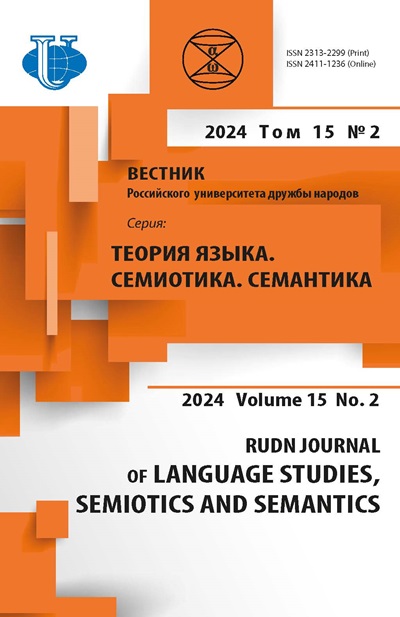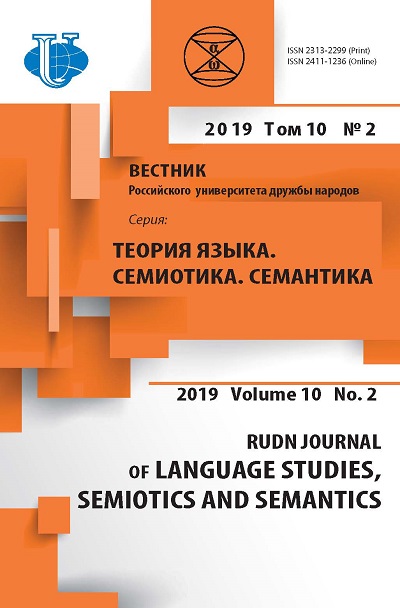REALIZATION OF TRANSFORMATION AND CREATIVE POTENTIAL OF THE KRYLATIKA IN MEDIA DISCOURSE
- Authors: Makarova A.S.1
-
Affiliations:
- St. Tikhon’s Orthodox University
- Issue: Vol 10, No 2 (2019)
- Pages: 273-287
- Section: PHRASE RESOURCES
- URL: https://journals.rudn.ru/semiotics-semantics/article/view/21749
- DOI: https://doi.org/10.22363/2313-2299-2019-10-2-273-287
Cite item
Full Text
Abstract
The modern process of the mediatisation of all spheres of public life affects both the volume of speech creation and the media texts themselves. The mass character and the multi-language openness of media discourse allow us to consider winged units as a means for representing and imple- menting phraseological innovations. The role of mass media in the formation of new sustainable turns is being actively studied, which speaks of their significance in this process, since it is the media discourse that demonstrates most clearly the current usage and viability of phraseological innovations in language and speech. The media discourse has a large number of ways of influencing the mass addressee, and, as recent studies of Russian media texts show, the fund of winged units as an integral part of the phraseological corpus of the national language is widely used in it. Various phrase resources (idioms, winged expressions, paremias, aphorisms, etc.) are often used both in a strong text position - the title or ending of the publication, and in the creation of media texts connecting the verbal and visual parts in which their transformational and creative potential is most clearly realized, multiplying their linguo-pragmatic effect on the addressee. The analysis of the media content of the site “Orthodox Laughs” revealed the tendency of creative use of folklorism “Баю-баюшки-баю, не ложися на краю. Придет серенький волчок - И укусит за бочок!”, which has not yet been fixed by lexicographical practice, as well as its variants that are the result of various methods of transformation language units. Structural and semantic transformations of various categories of phraseological units are an effective means of implementing specific expression in the media text. Previously, fiction was considered the main source of winged units, today the situation is changing, and the leadership belongs to synthetic art forms (cinema, television, pop, etc.). The analyzed potential winged unit has not one source of appearance: along with Russian and German folklore, this is German literature, but the expression in the Soviet animated film “The Bremen Town Musicians” was actualized. In analyzing the publications of this site, interdisciplinary methods of studying media content were used: discursive, descriptive-analytical, linguocultural, and media linguistic. The conducted research has shown that the functioning of the considered potential winged unit and its transforms confirms the thesis that these language units are in demand and widely used in modern media texts, since they have productive mechanisms of meaning formation.
Keywords
About the authors
Alexandra S. Makarova
St. Tikhon’s Orthodox University
Author for correspondence.
Email: aleste_63@mail.ru
PhD of Philology, Associate Professor, Associate Professor of the Department of Romance Philology and Foreign Languages of the Theological Faculty of St. Tikhon’s Orthodox University of Humanities
Likhov per., 6, Moscow, Russia, 127051References
- Bolshakova, L.S. (2008). On the Content of the Concept of “polycode Text”. Vestnik of Novgorod State University, 49, 48—51. (In Russ.)
- Dobrosklonskaya, T.G. (2008). Medialinguistics: systematic Approach to Learning the Language of the Media: Moscow, 2008 URL: http://www.ffl.msu.ru/research/publications/dobrosklonskaya/ dobrosklonskaya-medialingvistika.pdf (accessed: 26.02.2019). (In Russ.).
- Dobrosklonskaya, T.G. (2016). Methods for Analyzing video-verbal Texts. Medialinguistics, 2 (12), 13—25. (In Russ.)
- Erofeeva, I.V. (2009). Axiology of the Media Text in the Russian Culture (Value Reflection of Journalism of the Beginning of the XXI Century). Chita: Transbaikal State University Publ. (In Russ.).
- Konyushevich, M.I. (2014). The Ending of the Newspaper Text. Article One. Language and Speech. Medialinguistics, 1 (14), 89—100. (In Russ.).
- Gajda, S. (2010). Nowe media w perspektywie lingwistycznej. In Styl — dyskurs — media. B. Bogołębska, M. Worsowicz (Eds). Łódź. (In Polish).
- Van Dijk, Teun Adrianus (2013). Political Discourse and Ideology. Ethnolinguistics, 15.
- Dobrosklonskaya, T.G. (2014). Mass Media Discourse as an Object of scientific Description. Scientific Statements. Humanities Series, 13 (184), release 22, 181—187. (In Russ.).
- Uvarova, E.A. (2015). Media Text and Media Discourse: on the Problem of Concept Correlation. Vestnik MGOU. Series: Linguistics, 5, 47—54. (In Russ.).
- Babarika, N.A. (2010). Antique Origins and Sources of the international Fund of Winged Words and Expressions. Slavic Phraseology and Paremiology in the XXI Century. In Collection of scientific articles. E.E. Ivanova & V.M. Mokienko (Eds.). Minsk: Publisher Zmitser Kolas. pp. 253—256. (In Russ.).
- Walter, H. (2016). German political Posters from the Period of the Weimar Republic to the present Day. In Germany — Russia: Verbal and Visual Means of Modern Publicistic Discourse: A Collective Monograph. Graifswald: university them. Ernst Moritz Arndt Graifswald Publ. pp. 64—79. (In Russ.).
- Dyadechko, L.P. (2006). “Winged words sound”, or Russian Eptology. Kiev: KNU them. T. Shevchenko Publ. (In Russ.).
- Kamenev, K.V. (2009). Fixing in modern Dictionaries of Winged Units, going back to synthetic Art Genres. In Problems of History, Philology, Culture. Magnitogorsk State Technical University G.I. Nosova, 2 (24). pp. 115—119. (In Russ.).
- Lomakina, O.V. & Mokienko, V.M. (2017). The Role of Krylatka in the Internet Discourse: to the Formulation of the Problem. Firsov’s Readings. Linguistics in the XXI century: Interdisciplinary Paradigms: materials of reports and messages of the International Scientific and Practical Conference. Moscow, November 14—15, 2017. Moscow: RUDN Publ. 2017. pp. 247—254. (In Russ.)
- Teplyakova, A.O. (2012). Functions of Winged Words in Speech. Phraseology in Time and Space. Greifswald — Saint Petersburg Publ. pp. 149—151. (In Russ.).
- Shulezhkova, S.G. (2013). National and international in the Fund of Winged Units of the modern Russian Language. In Materials of the XV International Congress of Slavists August 20—27. Minsk. pp. 47—51. (In Russ.).
- Shulezhkova, S.G. & Makarova, A.S. (2016). Winged Expressions of French Origin in the international Block of modern Europe Slogans, RUDN Journal of Language Studies, Semiotics and Semantics, 4, 65—73. (In Russ.).
- Fink, J. (2016). On Phraseoshemes in Croatian Publicistic Discourse Titles. Medialinguistics, 3 (13), 83—91. (In Russ.).
- Lomakina, O.V. & Nelyubova, N.Yu. (2018). Fictional Text as a Basis for the Internet Meme: based on the Study of modern Receptions. Vestnik Tomskogo gosudarstvennogo Universiteta, 437, 36—44. doi: 10.17223/15617793/437/5. (In Russ.).
- Kunygina, O.V., Lomakina, O.V. & Makarova, A.S. (2019). Orthodoxy and the World Website as an Example of modern religious Discourse. Post massmedia in the modern informational society: achievements and problems: Proceedings of the III Conference of PMMIS, Chelyabinsk, March 28—29, 2019, M.V. Zagidullina (Eds.). Chelyabinsk: Izdatel'stvo Chelyabinskogo gosudarstvennogo universiteta. pp. 190—195. (In Russ.).
- Lomakina, O.V. (2019). Catchwords (Winged Words) in the Role of a modern Newspaper Headline: Composition, Usage Trends. Russian language abroad, 1, 37—41. (In Russ.).
- Makarova, A.S. (2017). Peculiarities of Transformations winged Gallicism Epressions in the Function of the Media Text Header (comparative Aspect). III Firsov’s Readings. Linguistics in the XXI century: Interdisciplinary Paradigms: Materials of Reports and Messages of the International Scientific and Practical Conference. Moscow, November 14—15, 2017. Moscow: RUDN. pp. 254—259. (In Russ.).
- Shulezhkova, S.G. (2002). The winged Expressions of the Russian Language, their Sources and Development. Moscow: “Azbukovnik”. (In Russ.).
- URL: http://www.stihi-rus.ru/deti/pesni.htm (accessed: 12.02.2019).
- URL: https://rostext.ru/text/tekst_pesni_bayubayushkibayu_6198103_1492360p88176185.html (accessed: 12.02.2019).
- Bredis, M.A. (2018). Germany: Pages of the Country’s History, Language and Culture. Moscow: Publishing House “De’Libri”, 2018. (In Russ.).
- Makarova, A.S. (2019). Cultural Potential of the Titles of the Films of the Soviet and Russian Periods (on the Material of the Texts of the Orthodox journalistic Discourse). National Codes in Language and Literature. Modern Languages in the new Conditions of Communication: a Collection of Articles on the Materials of the International Scientific Conference “National codes in language and literature”. Nizhny Novgorod: Izd-vo Nizhegorodskogo gosuniversiteta im. N.I. Lobachevskogo Publ. pp. 91—96. (In Russ.).
- Sannikov, V.Z. (2002). Russian Language in the Mirror of the Language Game. 2nd edition. Languages of Slavic Culture. Moscow. (In Russ.)
- Makarova, A.S. (2012). The Language Game in modern Periodicals as a Way of Influencing the Reader. Slavic cultural Space. Materials of the international scientific-practical Conference dedicated to the Day of Slavic Literature and Culture. Moscow, June 4—5, 2012: Reports V.A. Stepanenko (Eds.). Moscow: Pro100 Media. pp. 22—25. (In Russ.).
- Kovshova, M.L. (2010). Interaction of Language and Culture in Action: on the Example of the cultural Interpretation of phraseological Units. Live—Life Relationship of Language and Culture: Materials of the Intern. scientific Conf., dedicated to the Anniversary of the Doctor of Philology, Professor V.N. Telia; In 2 t. Moscow, Tula: Izd-vo Tul. gos. ped. un-ta im. L.N. Tolstogo Publ. V. 1. pp. 27—33. (In Russ.).
- Melerovich, A.M. & Mokienko, V.M. (2005). Idioms in Russian: Dictionary: approx. 1000 units. 2nd ed., Sr. Moscow: Russian Dictionaries: Astrel: AST. (In Russ.)













